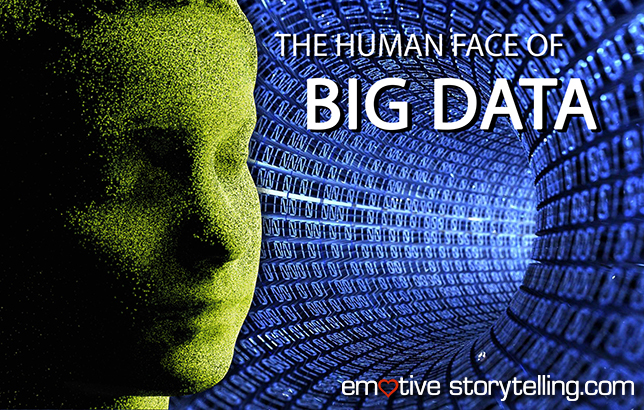
Emotive Storytelling is the sticky front end of Big Data.
A recent article in the Wall Street Journal, “Big Data Can Bring Patients to Water, But It Can’t Make Them Think” provides an excellent example of the frustration the medical/health insurance community experiences getting patients to act on recommendations for improved health.
It seems that Aetna, one of the largest health insurance companies in the U.S., has developed a way of crunching the data they have on their 18 million members, looking at lab tests, medication usage, and claims data. Their analytics platform allows them to predict which of these individuals have an increased chance of developing cardiovascular disease and diabetes. This is “Big Data” at its best. Apparently Aetna spends 6.5 billion dollars on coverage for cardiovascular disease alone. The article quotes Michael Palmer, head of innovation for Aetna, lamenting that despite providing their members with information on what they could do to reduce their risk of cardiovascular disease and diabetes, the information doesn’t seem change patient behavior.
Here are a couple of quotes from the article:
• “Palmer also noted that it’s difficult to get people to act on the information they’re given, even if it’s for their own good.”
• “A greater difficulty is getting people to act on the information they’re given.”
• “Getting people to do the right things for themselves is still a challenge.”
How have employers using Aetna plans tried to get more people to take their drugs as prescribed? They’ve used both reinforcement strategies (lower premium costs for those who comply with recommendations) and punishing strategies (charging employees more for their coverage if they refuse to take certain preventive tests).
Aetna has also chipped in to help employers control costs by increasing the adherence rate – the rate with which people take their drugs as prescribed – by eliminating co-pays for medications prescribed to people who had just had a heart attack.
The result of all of these “innovative” efforts aimed at changing health behavior? Not much. Almost 60 percent of the Aetna’s members aren’t moved to comply with recommendations.
With apologies to Mr. Palmer, head of innovation for Aetna, there is nothing “innovative” about these efforts to improve patient compliance. Appeals to reason and variations on reinforcement and punishment themes have been tried for decades. The seductive appeal of reasoned communication is that it should work. That’s what keeps everyone confused and why it is tried over and over, despite the fact that it doesn’t work.
The fact that these strategies don’t work for Aetna, or pretty much any other group trying to improve patient compliance in this manner, shouldn’t be news. If appeals to reason won’t work, what will?
We believe that a truly innovative approach is to integrate the power of narrative into the change efforts. We are at heart, emotional creatures. Emotion drives our behavior to a far greater degree than reason, despite our best efforts to hide that fact from ourselves. There is plenty of evidence, both scientific and from our own experience, that if emotive communication is part of the behavior change efforts, they are much more likely to succeed. Of course this isn’t really innovative, it’s how behavior has been successfully influenced for millennia.










Comments are closed.